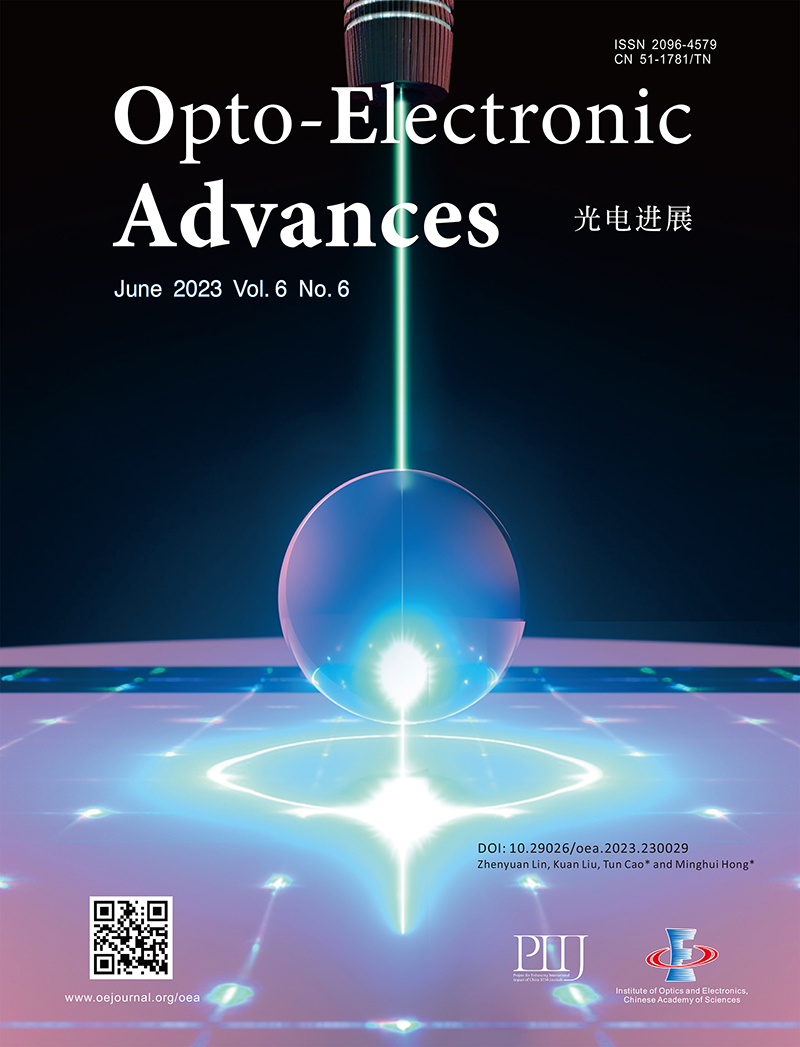| Citation: | Darian SB, Oh J, Paulson B et al. Multiphoton intravital microscopy in small animals of long-term mitochondrial dynamics based on super‐resolution radial fluctuations. Opto-Electron Adv 8, 240311 (2025). doi: 10.29026/oea.2025.240311 |
Multiphoton intravital microscopy in small animals of long-term mitochondrial dynamics based on super‐resolution radial fluctuations
-
Abstract
We developed an imaging technique combining two-photon computed super-resolution microscopy and suction-based stabilization to achieve the resolution of the single-cell level and organelles in vivo. To accomplish this, a conventional two-photon microscope was equipped with a 3D-printed holders, which stabilize the tissue surface within the focal plane of immersion objectives. Further computational image stabilization and noise reduction were applied, followed by super-resolution radial fluctuations (SRRF) analysis, doubling image resolution, and enhancing signal-to-noise ratios for in vivo subcellular process investigation. Stabilization of < 1 µm was obtained by suction, and < 25 nm were achieved by subsequent algorithmic image stabilization. A Mito-Dendra2 mouse model, expressing green fluorescent protein (GFP) in mitochondria, demonstrated the potential of long-term intravital subcellular imaging. In vivo mitochondrial fission and fusion, mitochondrial status migration, and the effects of alcohol consumption (modeled as an alcoholic liver disease) and berberine treatment on hepatocyte mitochondrial dynamics are directly observed intravitally. Suction-based stabilization in two-photon intravital imaging, coupled with computational super-resolution holds promise for advancing in vivo subcellular imaging studies. -

-
References
[1] Hoole S. The Select Works of Antony Van Leeuwenhoek (Henry Fry, London, 1798). [2] Pittet MJ, Weissleder R. Intravital imaging. Cell 147, 983–991 (2011). doi: 10.1016/j.cell.2011.11.004 [3] Saxena M, Eluru G, Gorthi SS. Structured illumination microscopy. Adv Opt Photon 7, 241–275 (2015). doi: 10.1364/AOP.7.000241 [4] Scheele CLGJ, Herrmann D, Yamashita E et al. Multiphoton intravital microscopy of rodents. Nat Rev Methods Primers 2, 89 (2022). doi: 10.1038/s43586-022-00168-w [5] Denk W, Strickler JH, Webb WW. Two-photon laser scanning fluorescence microscopy. Science 248, 73–76 (1990). doi: 10.1126/science.2321027 [6] Hong H, Wu CC, Zhao ZX et al. Giant enhancement of optical nonlinearity in two-dimensional materials by multiphoton-excitation resonance energy transfer from quantum dots. Nat Photon 15, 510–515 (2021). doi: 10.1038/s41566-021-00801-2 [7] Xia F, Wu CY, Sinefeld D et al. In vivo label-free confocal imaging of the deep mouse brain with long-wavelength illumination. Biomed Opt Express 9, 6545–6555 (2018). doi: 10.1364/BOE.9.006545 [8] Xu X, Luo Q, Wang JX et al. Large-field objective lens for multi-wavelength microscopy at mesoscale and submicron resolution. Opto-Electron Adv 7, 230212 (2024). doi: 10.29026/oea.2024.230212 [9] Liu S, Hoess P, Ries J. Super-resolution microscopy for structural cell biology. Annu Rev Biophys 51, 301–326 (2022). doi: 10.1146/annurev-biophys-102521-112912 [10] Huang YR, Zhang ZM, Tao WL et al. Multiplexed stimulated emission depletion nanoscopy (mSTED) for 5-color live-cell long-term imaging of organelle interactome. Opto-Electron Adv 7, 240035 (2024). doi: 10.29026/oea.2024.240035 [11] Bon P, Linarès-Loyez J, Feyeux M et al. Self-interference 3D super-resolution microscopy for deep tissue investigations. Nat Methods 15, 449–454 (2018). doi: 10.1038/s41592-018-0005-3 [12] Culley S, Tosheva KL, Pereira PM et al. SRRF: universal live-cell super-resolution microscopy. Int J Biochem Cell Biol 101, 74–79 (2018). doi: 10.1016/j.biocel.2018.05.014 [13] Gustafsson N, Culley S, Ashdown G et al. Fast live-cell conventional fluorophore nanoscopy with ImageJ through super-resolution radial fluctuations. Nat Commun 7, 12471 (2016). doi: 10.1038/ncomms12471 [14] Laine RF, Tosheva KL, Gustafsson N et al. NanoJ: a high-performance open-source super-resolution microscopy toolbox. J Phys D: Appl Phys 52, 163001 (2019). doi: 10.1088/1361-6463/ab0261 [15] Bond C, Santiago-Ruiz AN, Tang Q et al. Technological advances in super-resolution microscopy to study cellular processes. Mol Cell 82, 315–332 (2022). doi: 10.1016/j.molcel.2021.12.022 [16] Nguyen HTT, Kang SH. Base pair distance in single‐DNA molecule via TIRF‐based super‐resolution radial fluctuations‐stream module. Bull Korean Chem Soc 41, 476–479 (2020). doi: 10.1002/bkcs.11982 [17] Lee YH, Zhang S, Mitchell CK et al. Calcium imaging with super-resolution radial fluctuations. Biosci Bioeng 4, 78–84 (2018). [18] Zhang JB, Li N, Dong FH et al. Ultrasound microvascular imaging based on super‐resolution radial fluctuations. J Ultrasound Med 39, 1507–1516 (2020). doi: 10.1002/jum.15238 [19] Stubb A, Laine RF, Miihkinen M et al. Fluctuation-based super-resolution traction force microscopy. Nano Lett 20, 2230–2245 (2020). doi: 10.1021/acs.nanolett.9b04083 [20] Soulet D, Lamontagne‐Proulx J, Aubé B et al. Multiphoton intravital microscopy in small animals: motion artefact challenges and technical solutions. J Microsc 278, 3–17 (2020). doi: 10.1111/jmi.12880 [21] Vinegoni C, Lee S, Aguirre AD et al. New techniques for motion-artifact-free in vivo cardiac microscopy. Front Physiol 6, 147 (2015). [22] Warren SC, Nobis M, Magenau A et al. Removing physiological motion from intravital and clinical functional imaging data. eLife 7, e35800 (2018). doi: 10.7554/eLife.35800 [23] Lee S, Nakamura Y, Yamane K et al. Image stabilization for in vivo microscopy by high-speed visual feedback control. IEEE Trans Robot 24, 45–54 (2008). doi: 10.1109/TRO.2007.914847 [24] Lee S, Ozaki T, Nakamura Y. In vivo microscope image stabilization through 3-D motion compensation using a contact-type sensor. In 2008 IEEE/RSJ International Conference on Intelligent Robots and Systems 1192–1197 (IEEE, 2008). http://doi.org/10.1109/IROS.2008.4651123. [25] Vinegoni C, Lee S, Feruglio PF et al. Advanced motion compensation methods for intravital optical microscopy. IEEE J Sel Top Quantum Electron 20, 6800709 (2014). [26] Reichenspurner H, Detter C, Deuse T et al. Video and robotic-assisted minimally invasive mitral valve surgery: a comparison of the Port-Access and transthoracic clamp techniques. Ann Thorac Surg 79, 485–490 (2005). doi: 10.1016/j.athoracsur.2004.06.120 [27] Lee S, Vinegoni C, Feruglio PF et al. Real-time in vivo imaging of the beating mouse heart at microscopic resolution. Nat Commun 3, 1054 (2012). doi: 10.1038/ncomms2060 [28] Aguirre AD, Vinegoni C, Sebas M et al. Intravital imaging of cardiac function at the single-cell level. Proc Natl Acad Sci USA 111, 11257–11262 (2014). doi: 10.1073/pnas.1401316111 [29] Vinegoni C, Lee S, Gorbatov R et al. Motion compensation using a suctioning stabilizer for intravital microscopy. Intravital 1, 115–121 (2012). doi: 10.4161/intv.23017 [30] Kim Y, Cho M, Paulson B et al. Minimizing motion artifacts in intravital microscopy using the sedative effect of dexmedetomidine. Microsc Microanal 28, 1679–1686 (2022). doi: 10.1017/S1431927622000708 [31] Kiryu S, Sundaram T, Kubo S et al. MRI assessment of lung parenchymal motion in normal mice and transgenic mice with sickle cell disease. J Magn Reson Imaging 27, 49–56 (2008). doi: 10.1002/jmri.21035 [32] Presson RG Jr, Brown MB, Fisher AJ et al. Two-photon imaging within the murine thorax without respiratory and cardiac motion artifact. Am J Pathol 179, 75–82 (2011). doi: 10.1016/j.ajpath.2011.03.048 [33] Terry RJ. A thoracic window for observation of the lung in a living animal. Science 90, 43–44 (1939). doi: 10.1126/science.90.2324.43 [34] Looney MR, Thornton EE, Sen D et al. Stabilized imaging of immune surveillance in the mouse lung. Nat Methods 8, 91–96 (2011). doi: 10.1038/nmeth.1543 [35] Kim JK, Lee WM, Kim P et al. Fabrication and operation of GRIN probes for in vivo fluorescence cellular imaging of internal organs in small animals. Nat Protoc 7, 1456–1469 (2012). doi: 10.1038/nprot.2012.078 [36] Rodriguez-Tirado C, Kitamura T, Kato Y et al. Long-term high-resolution intravital microscopy in the lung with a vacuum stabilized imaging window. J Vis Exp 116, 54603 (2016). doi: 10.3791/54603 [37] Schrepfer E, Scorrano L. Mitofusins, from mitochondria to metabolism. Mol Cell 61, 683–694 (2016). doi: 10.1016/j.molcel.2016.02.022 [38] Youle RJ, Van Der Bliek AM. Mitochondrial fission, fusion, and stress. Science 337, 1062–1065 (2012). doi: 10.1126/science.1219855 [39] van der Bliek AM, Shen QF, Kawajiri S. Mechanisms of mitochondrial fission and fusion. Cold Spring Harb Perspect Biol 5, a011072 (2013). [40] Song ZY, Ghochani M, McCaffery JM et al. Mitofusins and OPA1 mediate sequential steps in mitochondrial membrane fusion. Mol Biol Cell 20, 3525–3532 (2009). doi: 10.1091/mbc.e09-03-0252 [41] López-Lluch G. Mitochondrial activity and dynamics changes regarding metabolism in ageing and obesity. Mech Ageing Dev 162, 108–121 (2017). doi: 10.1016/j.mad.2016.12.005 [42] Jheng HF, Tsai PJ, Guo SM et al. Mitochondrial fission contributes to mitochondrial dysfunction and insulin resistance in skeletal muscle. Mol Cell Biol 32, 309–319 (2012). doi: 10.1128/MCB.05603-11 [43] Duraisamy AJ, Mohammad G, Kowluru RA. Mitochondrial fusion and maintenance of mitochondrial homeostasis in diabetic retinopathy. Biochim Biophys Acta (BBA)-Mol Basis Dis 1865, 1617–1626 (2019). doi: 10.1016/j.bbadis.2019.03.013 [44] Babayeva A. Změny mitochondriálního metabolismu u nádorových buněk (2023). [45] Cederbaum AI, Lu YK, Wu DF. Role of oxidative stress in alcohol-induced liver injury. Arch Toxicol 83, 519–548 (2009). doi: 10.1007/s00204-009-0432-0 [46] Guo FF, Zheng K, Benedé‐Ubieto R et al. The Lieber‐DeCarli Diet—a flagship model for experimental alcoholic liver disease. Alcohol Clin Exp Res 42, 1828–1840 (2018). doi: 10.1111/acer.13840 [47] Ghosh Dastidar S, Warner JB, Warner DR et al. Rodent models of alcoholic liver disease: role of binge ethanol administration. Biomolecules 8, 3 (2018). doi: 10.3390/biom8010003 [48] Tillhon M, Ortiz LMG, Lombardi P et al. Berberine: new perspectives for old remedies. Biochem Pharmacol 84, 1260–1267 (2012). doi: 10.1016/j.bcp.2012.07.018 [49] Yan XJ, Yu X, Wang XP et al. Mitochondria play an important role in the cell proliferation suppressing activity of berberine. Sci Rep 7, 41712 (2017). doi: 10.1038/srep41712 [50] Schindelin J, Arganda-Carreras I, Frise E et al. Fiji: an open-source platform for biological-image analysis. Nat Methods 9, 676–682 (2012). doi: 10.1038/nmeth.2019 [51] Mannam V, Zhang YD, Zhu YH et al. Real-time image denoising of mixed Poisson–Gaussian noise in fluorescence microscopy images using ImageJ. Optica 9, 335–345 (2022). doi: 10.1364/OPTICA.448287 [52] Culley S, Albrecht D, Jacobs C et al. Quantitative mapping and minimization of super-resolution optical imaging artifacts. Nat Methods 15, 263–266 (2018). doi: 10.1038/nmeth.4605 [53] Kim E, Lee S, Park SB. A Seoul-Fluor-based bioprobe for lipid droplets and its application in image-based high throughput screening. Chem Commun 48, 2331–2333 (2012). doi: 10.1039/c2cc17496k [54] Lee Y, Na S, Lee S et al. Optimization of Seoul-Fluor-based lipid droplet bioprobes and their application in microalgae for bio-fuel study. Mol BioSyst 9, 952–956 (2013). doi: 10.1039/c2mb25479d [55] Kirpich I, Ghare S, Zhang J W et al. Binge alcohol–induced microvesicular liver steatosis and injury are associated with down‐regulation of hepatic Hdac 1, 7, 9, 10, 11 and up‐regulation of Hdac 3. Alcohol Clin Exp Res 36, 1578–1586 (2012). [56] Bertola A, Mathews S, Ki SH et al. Mouse model of chronic and binge ethanol feeding (the NIAAA model). Nat Protoc 8, 627–637 (2013). doi: 10.1038/nprot.2013.032 [57] Lefebvre AEYT, Ma D, Kessenbrock K et al. Author correction: automated segmentation and tracking of mitochondria in live-cell time-lapse images. Nat Methods 19, 770 (2022). [58] Valente AJ, Maddalena LA, Robb EL et al. A simple ImageJ macro tool for analyzing mitochondrial network morphology in mammalian cell culture. Acta Histochem 119, 315–326 (2017). doi: 10.1016/j.acthis.2017.03.001 [59] Zhang PC, Ma DS, Wang YC et al. Berberine protects liver from ethanol-induced oxidative stress and steatosis in mice. Food Chem Toxicol 74, 225–232 (2014). doi: 10.1016/j.fct.2014.10.005 [60] Xu LL, Zheng X, Wang YH et al. Berberine protects acute liver failure in mice through inhibiting inflammation and mitochondria-dependent apoptosis. Eur J Pharmacol 819, 161–168 (2018). doi: 10.1016/j.ejphar.2017.11.013 [61] Zhou R, Lin JJ, Wu DF. Sulforaphane induces Nrf2 and protects against CYP2E1-dependent binge alcohol-induced liver steatosis. Biochim Biophys Acta (BBA)-Gen Subj 1840, 209–218 (2014). doi: 10.1016/j.bbagen.2013.09.018 [62] Feldman AT, Wolfe D. Tissue processing and hematoxylin and eosin staining. Methods Mol Biol 1180, 31–43 (2014). [63] Banterle N, Bui KH, Lemke EA et al. Fourier ring correlation as a resolution criterion for super-resolution microscopy. J Struct Biol 183, 363–367 (2013). doi: 10.1016/j.jsb.2013.05.004 [64] Koho S, Tortarolo G, Castello M et al. Fourier ring correlation simplifies image restoration in fluorescence microscopy. Nat Commun 10, 3103 (2019). doi: 10.1038/s41467-019-11024-z [65] Woolrich MW, Ripley BD, Brady M et al. Temporal autocorrelation in univariate linear modeling of FMRI data. Neuroimage 14, 1370–1386 (2001). doi: 10.1006/nimg.2001.0931 [66] Lieber CS, DeCarli LM. Liquid diet technique of ethanol administration: 1989 update. Alcohol Alcohol 24, 197–211 (1989). [67] Lefebvre AEYT, Ma D, Kessenbrock K et al. Automated segmentation and tracking of mitochondria in live-cell time-lapse images. Nat Methods 18, 1091–1102 (2021). doi: 10.1038/s41592-021-01234-z [68] Carvalho JCO, Palero JA, Jurna M. Real-time imaging of suction blistering in human skin using optical coherence tomography. Biomed Opt Express 6, 4790–4795 (2015). doi: 10.1364/BOE.6.004790 [69] Shimizu K, Higuchi Y, Kozu Y et al. Development of a suction device for stabilizing in vivo real-time imaging of murine tissues. J Biosci Bioeng 112, 508–510 (2011). doi: 10.1016/j.jbiosc.2011.07.015 [70] Uechi M, Asai K, Osaka M et al. Depressed heart rate variability and arterial baroreflex in conscious transgenic mice with overexpression of cardiac Gsα. Circ Res 82, 416–423 (1998). doi: 10.1161/01.RES.82.4.416 [71] Wackenfors A, Sjögren J, Gustafsson R et al. Effects of vacuum‐assisted closure therapy on inguinal wound edge microvascular blood flow. Wound Repair Regener 12, 600–606 (2004). doi: 10.1111/j.1067-1927.2004.12602.x [72] Smyth CN. Effect of suction on blood-flow in ischæmic limbs. Lancet 294, 657–659 (1969). doi: 10.1016/S0140-6736(69)90373-0 [73] Paulson B, Darian SB, Kim Y et al. Spectral multiplexing of fluorescent endoscopy for simultaneous imaging with multiple fluorophores and multiple fields of view. Biosensors 13, 33 (2022). doi: 10.3390/bios13010033 [74] You M, Arteel GE. Effect of ethanol on lipid metabolism. J Hepatol 70, 237–248 (2019). doi: 10.1016/j.jhep.2018.10.037 [75] Tilg H, Moschen AR, Kaneider NC. Pathways of liver injury in alcoholic liver disease. J Hepatol 55, 1159–1161 (2011). doi: 10.1016/j.jhep.2011.05.015 [76] Lieber CS, Rubin E, DeCarli LM. Hepatic microsomal ethanol oxidizing system (MEOS): differentiation from alcohol dehydrogenase and NADPH oxidase. Biochem Biophys Res Commun 40, 858–865 (1970). doi: 10.1016/0006-291X(70)90982-4 [77] Jaeschke H. Reactive oxygen and mechanisms of inflammatory liver injury: present concepts. J Gastroenterol Hepatol 26, 173–179 (2011). doi: 10.1111/j.1440-1746.2010.06592.x [78] Ke XM, Zhang RY, Li P et al. Hydrochloride Berberine ameliorates alcohol-induced liver injury by regulating inflammation and lipid metabolism. Biochem Biophys Res Commun 610, 49–55 (2022). doi: 10.1016/j.bbrc.2022.04.009 [79] Hori I, Harashima H, Yamada Y. Development of a mitochondrial targeting lipid nanoparticle encapsulating berberine. Int J Mol Sci 24, 903 (2023). doi: 10.3390/ijms24020903 [80] Yu WL, Sheng MW, Xu RB et al. Berberine protects human renal proximal tubular cells from hypoxia/reoxygenation injury via inhibiting endoplasmic reticulum and mitochondrial stress pathways. J Transl Med 11, 24 (2013). doi: 10.1186/1479-5876-11-24 [81] Rosen M, Hillard EK. The use of suction in clinical medicine. Br J Anaesth 32, 486–504 (1960). doi: 10.1093/bja/32.10.486 -
Supplementary Information
-
Access History

Article Metrics
-
Figure 1.
Schematic of suction-based stabilization for super-resolution radial fluctuations (SRRF) intravital imaging. (a) Schematic of intravital imaging setup with a suction-based stabilizer attached to the objective lens of a two-photon microscope. (b) Simulation of the expected stabilization effect on tissue displacement due to cardiac and respiratory motion. (c) Schematic of software drift correction and registration, followed by image postprocessing. Subsequent subpixel production and radiality analysis using the SRRF algorithm are depicted. (bottom left) Different ring radius values result in different effects on biological images.
-
Figure 2.
Comparisons between conventional two-photon and SRRF-assisted two-photon imaging. (a) SRRF imaging improves upon conventional two-photon imaging in the resolution of fine features when imaging fluorescent micro-beads. (b) FRC analysis comparing the resolution of conventional and enhanced tissue imaging demonstrates a significant improvement in SRRF resolution, averaging 250 nm. (Inset) FRC maps depict the image resolution in both the original and enhanced imaging of a fluorescent bead sample.
-
Figure 3.
Suction stabilization was assessed using epidermal two-photon imaging of mito-Dendra2 mice. (a) Unstabilized (top) and stabilized (bottom) frames from a 2.5 s video show improved image consistency in the stabilized frames due to axial tissue stabilization, as indicated by the yellow lines in (b). Red triangles and yellow circles demonstrate movement of features of interest between frames. (b) Image intensity variance comparison reveals reduced variability in the stabilized stack, with more consistent temporal autocorrelation (i) along the highlighted profile, (ii) comparing the spatial average and intensity variance of the profile and full image, (iii) correlated intensity over the profile and whole-image changes more in the unstabilized image. (iv) Temporal correlations are more consistent in the stabilized image. (c) 3D projections highlight the stabilization effect in both hardware and software. (d) Schematic illustrates how suction reduces pixel shift and stabilizes pixel intensity. (e) Suction also minimizes pixel drift, stabilizing pixel intensity.
-
Figure 4.
Intravital two-photon skin and liver imaging with suction stabilization. (a) Comparison between the original image (left, red line) and the enhanced version (middle, yellow line), with the merged image (right) displaying half of the original image overlaid with the enhanced image for direct visual contrast. (b) Pixel intensities shown along the solid and dashed profiles, revealing sharper image features in the enhanced image. (c) Demonstrate original hepatocyte imaging. (d) Hepatocyte imaging with denoising, image registration, and SRRF. Scale bar, 10 µm. (e) Schematic of z-scan enhanced imaging enabled by image stabilization, showing image stacks at depths from 40 µm. (f) 3D visualizations of the enhanced image z-stack. The upper row shows the hepatocytes and the lower one demonstrates the blood vessels tagged by Texas red dextran.
-
Figure 5.
Effects of ethanol (EtOH) and berberine (BBR) treatment on the mitochondrial network in the exteriorized mouse liver. (a) Two-photon enhanced images from the mouse liver show changes in mitochondrial morphology under treatment with ethanol and different concentrations of BBR. (b) From left to right: mitochondrial length, solidity, circularity, and roundness, as calculated from enhanced images. The average mitochondrial length is reduced by ethanol and restored by treatment with BBR. (c) Histograms showing the distribution of mitochondria with different values of circularity, roundness, and solidity, for the control, ethanol treatment, and treatment with doses of 7 and 10 mg BBR. P values are determined using two-tailed t-test. *P < 0.05, **P < 0.01, ***P < 0.001, ****P < 0.0001.
-
Figure 6.
Live intravital tracking of mitochondrial transitions using suction-stabilized two-photon imaging with SRRF. (a) Contextual image showing an optical liver section from an untreated mouse. (b) Intravital time-lapse fission and fusion of individual mitochondria. (Arrows) fusion; (arrowheads) fission. (c) Segmentation and tracking of mitochondrial migration in control, EtOH-fed, and BBR-treated groups with randomly labeled objects in the lower corner (first row) and tracking mitochondria (second row). (d) Major and minor axis, solidity, displacement, and speed of individual mitochondria in three different groups of mice. P values are determined using two-tailed t-test. *P < 0.05, **P < 0.01, ***P < 0.001, ****P < 0.0001.

 E-mail Alert
E-mail Alert RSS
RSS




 DownLoad:
DownLoad:







